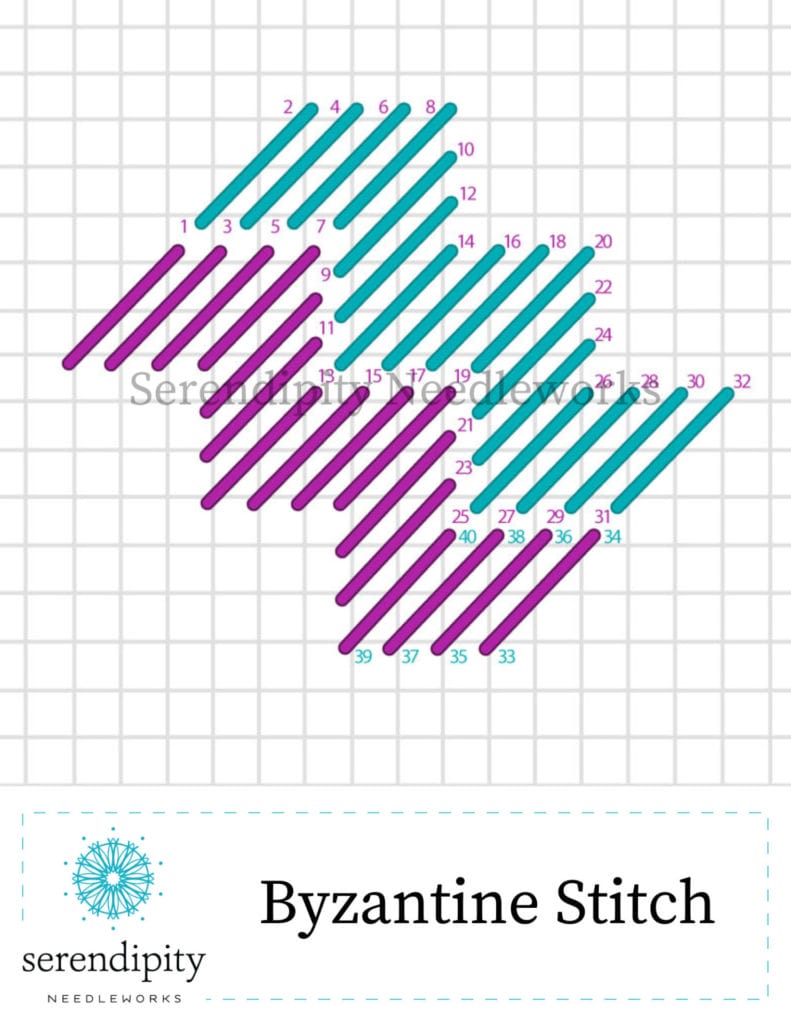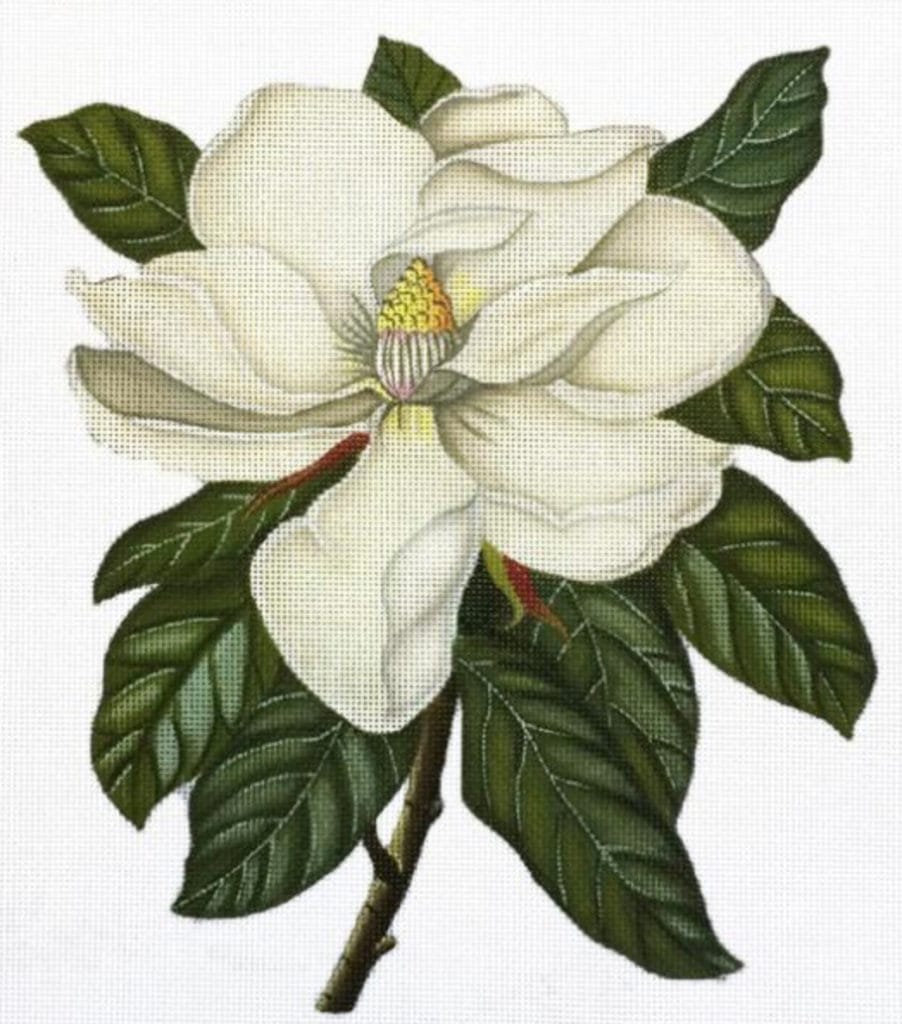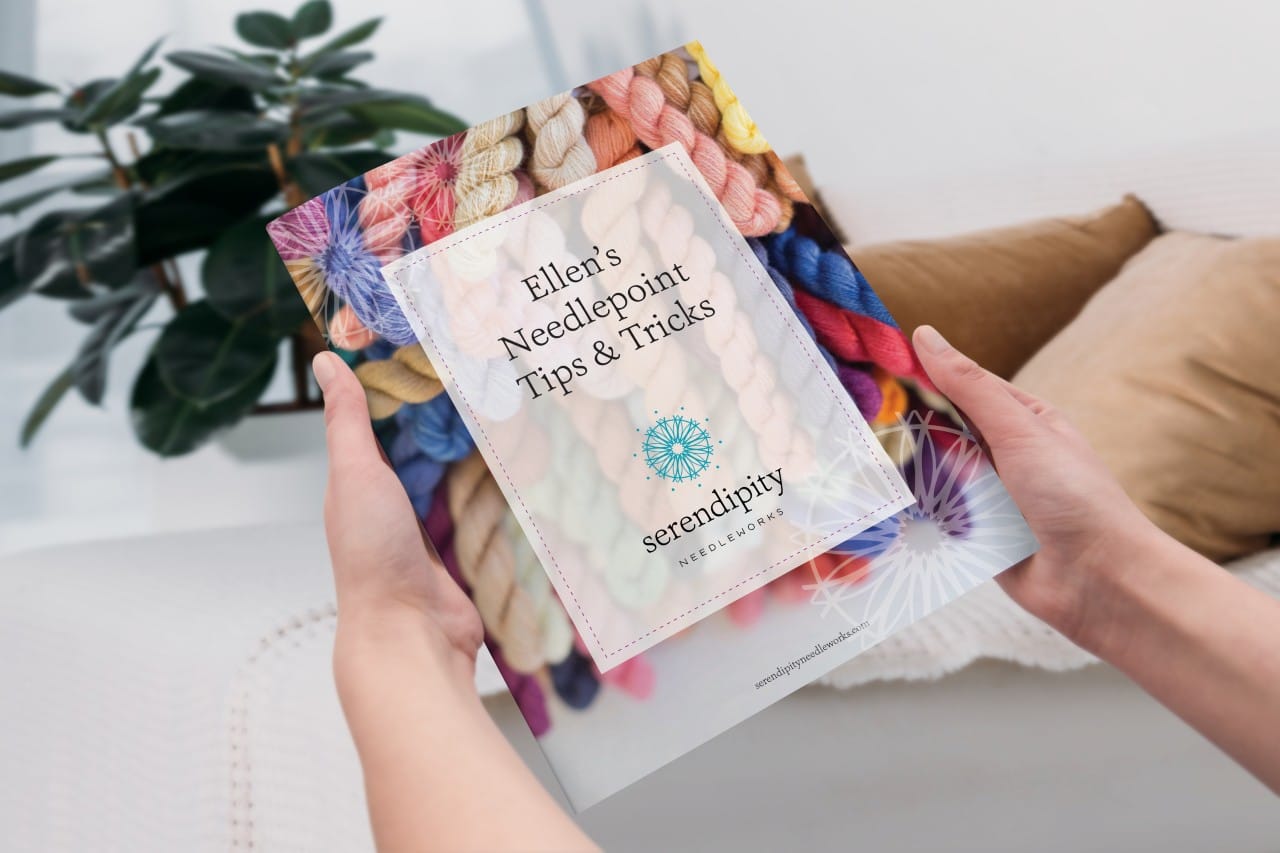The Byzantine stitch is one of the first canvas embroidery stitches that I learned. It’s one of the most versatile stitch patterns of all – and you’ll find a LOT of variations of it in your stitch books. In fact, that’s a variation of the Byzantine Scotch stitch on Jingle’s scarf in the picture above.
Another name for the Byzantine stitch is the “step” stitch.
And it does, indeed, look like stairs. The original Byzantine stitch features 4 stitches per “step”. (I say “original” because this is the iteration of the stitch that the Embroider’s Guild of America recognizes for their Master Craftsman program in Canvas Embroidery.)
Here’s the diagram for you…

The most important thing to remember when executing the Byzantine stitch…
is that the last stitch of the step you just worked also serves as the first stitch in the next step. In other words, if you’ve just completed 4 horizontal stitches in the pattern, the last “horizontal row” stitch also serves as the first stitch in the series of 4 vertical stitches that you’re now ready to create.
Since the Byzantine stitch is a larger stitch, you’ll need plenty of space to establish the pattern in order to achieve the best effect. Backgrounds are a terrific way to utilize it. Some other fantabulous ways to use this stitch are for large bodies of water, as a filler stitch, and for articles of clothing.
So let’s take a look at large bodies of water first.
If you have a beach scene with a big expanse of ocean, you can create eye-catching movement with the Byzantine stitch. This stitch “reads” diagonal which can mimic the waves coming ashore on the beach – especially if you use a thread like Petite Frosty Rays. The sparkle that you get from the metallic thread shot through the center of the Flair makes it look like the sun is glinting off the surface of the water when the light hits your canvas “just so”.
A few of my favorite shades of Petite Frosty Rays for the aquamarine waters of the Caribbean are PY423, PY424, and PY426. And if the body of water on your canvas is more inky blue, try PY040 and/or PY042. (Hint: You may also use this stitch to create a very realistic looking waterfall! Just remember that you should be able to get three repeats of the stitch in the space for the best results.)
Wondering how to use the Byzantine stitch as a filler?
One of my all-time favorite ways is on large flowers, like “Vintage Magnolia” from Melissa Shirley Designs (below).

Using a smattering of canvas embroidery stitches to add visual (and stitching!) interest to the petals on this beauty would make it even more outstanding than it already is. And where might the Byzantine stitch fit in? I can definitely envision using it on that droopy petal at the bottom of the blossom.
Since you’re not necessarily striving to achieve “realism” if you choose to use the Byzantine stitch as a filler stitch on flower petals, your thread options are limited only by your imagination.
I won’t leave you wondering, though. Some of my favorite threads for stitching flower petals are Splendor, DMC cotton embroidery floss, and Vineyard Silk. The color palette of each of those threads is luscious and you’re sure to find just the right hue.
Alrighty – we’re coming down the homestretch now.
The third place I’m particularly fond of using the Byzantine stitch is for clothing embellishment.
Why’s that, you’re wondering? You see, the Byzantine stitch is a prime candidate for “reverse” stitching. For example, in our original diagram, the steps slant downhill to the right. But you can reverse the slant of each stitch – and the direction that the steps go – so that the Byzantine stitch angles toward the left.
And it’s that little twist which makes it the perfect choice for any garment where you want to imply symmetrical balance – like sleeves! Or the front panels of Santa’s robe.
Some amazing threads for stitching fancy garments are PepperPot Silk (18 mesh) Planet Earth Silk (13 mesh), Neon Rays (13 & 18 mesh), Silk Lame Braid (13 & 18 mesh), and Very Velvet/Petite Very Velvet (13 & 18 mesh). All of those threads are sumptuous and luxurious. But if you want to create more casual clothing, you can use threads such as Rainbow Linen (18 mesh), Waverly Wool (13 & 18 mesh), Vineyard Merino (18 mesh), and Rainbow Tweed (13 & 18 mesh).
Alrighty, my friend… that brings us to the end of our peek at the Byzantine stitch. Thank you ever so much for stopping by for a visit. I hope you have a terrific week and I’ll see you again next time.
XOXO!! ❤️

PS: Did you know that I share fun posts almost every day on social media? You can get oodles of terrific tips and needlepoint goodness when you follow me here and here. 😉❤️







I have stitched for 50 years and I always learn something from you.!!
Awww… thank you, Dianne! You just made my day!! 🙂
Thank you! I’m venturing into new stitches – currently brick stitch as it so forgiving and easy to compensate. You are giving me encouragement to branch out more!
Hooray… I’m so glad to hear you’re trying new things! Please keep us posted on your progress. 🙂
Thank you, Ellen. Great information and Encouragement…
You’re very welcome, Shirley! And thank YOU for being part of our Stitcher’s Club family!! 🙂